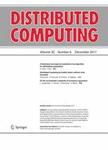版权所有:内蒙古大学图书馆 技术提供:维普资讯• 智图
内蒙古自治区呼和浩特市赛罕区大学西街235号 邮编: 010021

作者机构:INRIA Rennes France Univ Calgary Calgary AB Canada
出 版 物:《DISTRIBUTED COMPUTING》 (分布式计算)
年 卷 期:2019年第32卷第6期
页 面:565-586页
核心收录:
学科分类:08[工学] 0812[工学-计算机科学与技术(可授工学、理学学位)]
主 题:Distributed computer systems
摘 要:We study randomized test-and-set (TAS) implementations from registers in the asynchronous shared memory model with n processes. We introduce the problem of group election, a natural variant of leader election, and propose a framework for the implementation of TAS objects from group election objects. We then present two group election algorithms, each yielding an efficient TAS implementation. The first implementation has expected max-step complexity O(log* k) in the location-oblivious adversary model, and the second has expected max-step complexity O(log log k) against any read/write-oblivious adversary, where k = n is the contention. These algorithms improve the previous upper bound by Alistarh and Aspnes (in: Proceedings of the 25th International Symposium on Distributed Computing, 2011) of O(log log n) expected max-step complexity in the oblivious adversary model. We also propose a modification to a TAS algorithm devised by Alistarh, Attiya, Gilbert, Giurgiu, and Guerraoui (in: Proceedings of the 24th International Symposium on Distributed Computing, DISC 2010) for the strong adaptive adversary, which improves its space complexity from super-linear to linear, while maintaining its O(log n) expected max-step complexity. We then describe how this algorithm can be combined with any randomized TAS algorithm that has expected max-step complexity T (n) in a weaker adversary model, so that the resulting algorithm has O(log n) expected max-step complexity against any strong adaptive adversary and O(T (n)) in the weaker adversary model. Finally, we prove that for any randomized 2-process TAS algorithm, there exists a schedule determined by an oblivious adversary such that with probability at least 1/4t one of the processes needs at least t steps to finish its TAS operation. This complements a lower bound by Attiya and Censor-Hillel (SIAM J Comput 39(8):3885-3904, 2010) on a similar problem for n = 3 processes.